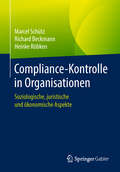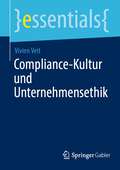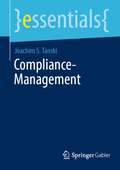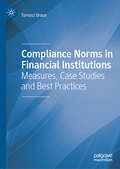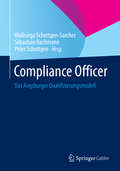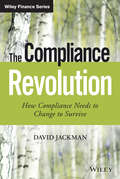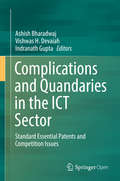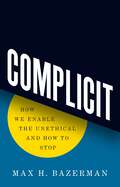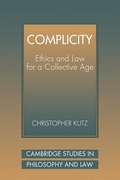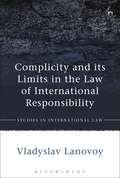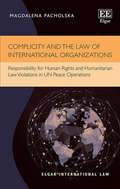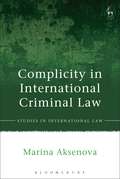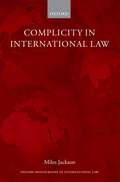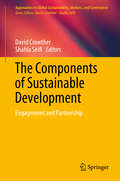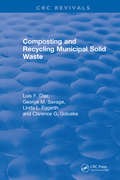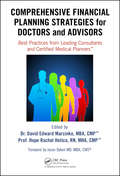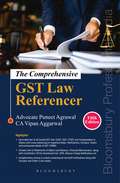- Table View
- List View
Compliance-Kontrolle in Organisationen
by Marcel Schütz Richard Beckmann Heinke RöbkenDas Buch bietet eine systematische und interdisziplinäre Darstellung zur Compliance-Kontrolle in Unternehmen, Verwaltungen und weiteren Einrichtungen. Die Autoren befassen sich mit der Diskussion entsprechender Regelwerke bzw. Konzepte sowie den organisatorischen Folgen. Hierzu entwickeln sie sozial-, rechts- und wirtschaftswissenschaftliche Bezüge einer Analyse und Gestaltung organisatorischer Regelsetzung und -begründung. Besonderes Augenmerk gilt dem Spannungsverhältnis formaler und informaler Ordnung sowie dem Ansatz der „brauchbaren Illegalität“. Das Werk richtet sich an mit Compliance-Aspekten beschäftigte Wissenschaftler sowie Experten und Entscheider in Organisationen aller Art.
Compliance-Kultur und Unternehmensethik (essentials)
by Vivien VeitDieses essential beschäftigt sich mit der Frage, was neben einem fundierten Compliance-Management-System nötig ist, um nachhaltig und belastbar eine Kultur der Regeltreue im Unternehmen zu erreichen. Hierzu werden die derzeitigen regulatorischen Ansätze im In- und Ausland sowie Tools und Bausteine vorgestellt, die eine solche Entwicklung begünstigen. Kombiniert mit zahlreichen Statements und konkreten Beispielen und Erfahrungsberichten von Unternehmensvertretern, Beratern und Behördenvertretern entsteht eine Toolbox für Compliance-Verantwortliche, die die Arbeit an individuellen Lösungen erleichtert und darüber hinaus Inspiration für neue Ansätze im eigenen Unternehmen sein kann.
Compliance-Management (essentials)
by Joachim S. TanskiDieses Buch bietet eine komprimierte und praxisorientierte Einführung in die Grundlagen und Anforderungen eines Compliance-Managements, um den Leser schnell mit aktuellen und zentralen Regelungen vertraut zu machen. Dabei wird auf gesetzliche und regulatorische Bestimmungen ebenso eingegangen wie auf betriebswirtschaftliche Notwendigkeiten, um Mitarbeitende und Unternehmen vor den schwerwiegenden Folgen von Compliance-Verstößen zu schützen.
Compliance Norms in Financial Institutions: Measures, Case Studies and Best Practices
by Tomasz BraunInitially, introducing compliance functions within the financial industry had been forced by regulatory scrutiny. Later, it started to spread to other regulated companies, in particular those publicly listed. Now, compliance has become an asset of corporates that want to build their reliability among clients, shareholders, employees and business partners. This book looks at the efficiency of the compliance measures introduced and the best practices of building compliance norms.This recently observed practice of compliance was triggered by the expectation of regulators, shareholders, clients, business partners and the public for robust compliance mechanisms. This book looks at the vast interest in this topic among business people who strive to introduce the systems and the mechanisms of non-compliance risk management in their companies and at the uncountable difficulties and obstacles they meet. The book fills the gap of thorough analysis of this subject by pointing out the solutions successfully introduced in global financial organizations, and would be of interest to academics, researchers and practitioners in corporate finance, corporate governance and risk management.
Compliance Officer: Das Augsburger Qualifizierungsmodell
by Walburga Schettgen-Sarcher Sebastian BachmannAufbau, Implementierung und Gelebtwerden einer Compliance-Organisation in Unternehmen erfordern eine ganzheitliche Sichtweise auf das Thema. Ausgehend von juristischen und betriebswirtschaftlichen Fragestellungen beleuchten die Beiträge dieses Bandes die wichtigsten Compliance-Risiken in Unternehmen. Die Autoren diskutieren die Implementierung im Rahmen der Unternehmensorganisation und legen besonderes Augenmerk auf die IT-Strukturen. Die persönlichen Anforderungen an den Compliance-Beauftragten sowie die ethische Verantwortung im Bereich der Compliance bilden einen weiteren Schwerpunkt. Die konsequent praxisorientierte Behandlung des Themas Compliance wird im Kapitel "Praxisfragen der Compliance" mit Themen wie Compliance und M&A, Collective Action, Compliance im Konzern explizit betont.
The Compliance Revolution: How Compliance Needs to Change to Survive
by David JackmanThe Compliance Revolution—Practical, Powerful Changes for Strategic Organizational Value Compliance is absolutely critical in creating a robust and resilient organization, one which is trusted by clients and contributes to market stability. Firms must approach compliance differently in order to meet these standards. Written for compliance staff, regulatory organizations, and senior management, The Compliance Revolution explains how key changes in compliance affect underlying principles, practices, roles, expectations and values. This valuable resource for global practitioners assists in navigating compliance requirements and implementing solid protection for a sound organization. Author David Jackman presents a coherent model for understanding and applying key developments in regulation and compliance. While the model is based on financial services, it can be applied to any sector and industry. It identifies five critical compliance components: Start-up, crises, expansion, sustainability, and outcomes-led focus. You will also discover: Why compliance is worth spending money on What your firm could and should be doing differently The importance of ethics in compliance and regulatory challenges How to create a pro-compliance culture Ten principles of good governance and why good governance matters How to employ judgment-based compliance The features and benefits of corporate maturity The Compliance Revolution is a crucial asset for all those with stakes in compliance—board members, compliance managers, and employees. David Jackman outlines key compliance challenges and reveals the practical tools and techniques required for successful practice. The insight, examples, and strategies in this comprehensive guidebook will help you and your organization achieve increasingly efficient, substantially more effective compliance procedures and practices.
The Compliance Revolution: How Compliance Needs to Change to Survive
by David JackmanThe Compliance Revolution—Practical, Powerful Changes for Strategic Organizational Value Compliance is absolutely critical in creating a robust and resilient organization, one which is trusted by clients and contributes to market stability. Firms must approach compliance differently in order to meet these standards. Written for compliance staff, regulatory organizations, and senior management, The Compliance Revolution explains how key changes in compliance affect underlying principles, practices, roles, expectations and values. This valuable resource for global practitioners assists in navigating compliance requirements and implementing solid protection for a sound organization. Author David Jackman presents a coherent model for understanding and applying key developments in regulation and compliance. While the model is based on financial services, it can be applied to any sector and industry. It identifies five critical compliance components: Start-up, crises, expansion, sustainability, and outcomes-led focus. You will also discover: Why compliance is worth spending money on What your firm could and should be doing differently The importance of ethics in compliance and regulatory challenges How to create a pro-compliance culture Ten principles of good governance and why good governance matters How to employ judgment-based compliance The features and benefits of corporate maturity The Compliance Revolution is a crucial asset for all those with stakes in compliance—board members, compliance managers, and employees. David Jackman outlines key compliance challenges and reveals the practical tools and techniques required for successful practice. The insight, examples, and strategies in this comprehensive guidebook will help you and your organization achieve increasingly efficient, substantially more effective compliance procedures and practices.
Compliance with International Human Rights Law in Africa: Essays in Honour of Frans Viljoen
by Aderomola AdeolaThis collection of essays in honour of Frans Viljoen shines a light on the increasingly important place of compliance in international law. With essays from leading scholars in the field of international human rights law, this festschrift provides compelling analysis of the nature of compliance in the African human rights context, the challenges that affect its place in these legal systems, and the ways in which increased compliance can be achieved. The volume is divided into three parts exploring: theoretical perspectives, thematic perspectives, and institutional perspectives. Each in turn helps to build a picture of theory and practice charting the historic developments of human rights law with several case studies to illustrate. Contributors provide detailed comparison with other national legal systems, such as the Inter-American IACHR and Court, placing these reflections in their global comparative context. The work concludes by considering the ways in which challenges can be overcome to achieve increased compliance with international human rights law in Africa. Compliance with International Human Rights Law in Africa is not only a work to honour the contributions of Frans Viljoen but is also an invaluable resource for researchers, practitioners, and policy makers, in the field of international human rights law.
Compliance with International Human Rights Law in Africa: Essays in Honour of Frans Viljoen
by Aderomola AdeolaThis collection of essays in honour of Frans Viljoen shines a light on the increasingly important place of compliance in international law. With essays from leading scholars in the field of international human rights law, this festschrift provides compelling analysis of the nature of compliance in the African human rights context, the challenges that affect its place in these legal systems, and the ways in which increased compliance can be achieved. The volume is divided into three parts exploring: theoretical perspectives, thematic perspectives, and institutional perspectives. Each in turn helps to build a picture of theory and practice charting the historic developments of human rights law with several case studies to illustrate. Contributors provide detailed comparison with other national legal systems, such as the Inter-American IACHR and Court, placing these reflections in their global comparative context. The work concludes by considering the ways in which challenges can be overcome to achieve increased compliance with international human rights law in Africa. Compliance with International Human Rights Law in Africa is not only a work to honour the contributions of Frans Viljoen but is also an invaluable resource for researchers, practitioners, and policy makers, in the field of international human rights law.
Complications and Quandaries in the ICT Sector: Standard Essential Patents and Competition Issues
by Ashish Bharadwaj Vishwas H. Devaiah Indranath GuptaThis book is open access under a CC BY 4.0 license.With technology standards becoming increasingly common, particularly in the information and communications technology (ICT) sector, the complexities and contradictions at the interface of intellectual property law and competition law have emerged strongly. This book talks about how the regulatory agencies and courts in the United States, European Union and India are dealing with the rising allegations of anti-competitive behaviour by standard essential patent (SEP) holders. It also discusses the role of standards setting organizations / standards developing organizations (SSO/SDO) and the various players involved in implementing the standards that influence practices and internal dynamics in the ICT sector. This book includes discussions on fair, reasonable and non-discriminatory (FRAND) licensing terms and the complexities that arise when both licensors and licensees of SEPs differ on what they mean by “fair”, “reasonable” and “non-discriminatory” terms. It also addresses topics such as the appropriate royalty base, calculation of FRAND rates and concerns related to FRAND commitments and the role of Federal Trade Commission (FTC) in collaborative standard setting process. This book provides a wide range of valuable information and is a useful tool for graduate students, academics and researchers.
Complicit: How We Enable the Unethical and How to Stop
by Max H. BazermanWhat all of us can do to fight the pervasive human tendency to enable wrongdoing in the workplace, politics, and beyondIt is easy to condemn obvious wrongdoers such as Elizabeth Holmes, Harvey Weinstein, and the Sackler family. But we rarely think about the many people who supported their unethical or criminal behavior. In each case there was a supporting cast of complicitors: business partners, employees, investors, news organizations, and others. And, whether we’re aware of it or not, almost all of us have been complicit in the unethical behavior of others. In Complicit, Harvard Business School professor Max Bazerman confronts our complicity head-on and offers strategies for recognizing and avoiding the psychological and other traps that lead us to ignore, condone, or actively support wrongdoing in our businesses, organizations, communities, politics, and more.Complicit tells compelling stories of those who enabled the Theranos and WeWork scandals, the opioid crisis, the sexual abuse that led to the #MeToo movement, and the January 6th U.S. Capitol attack. The book describes seven different behavioral profiles that can lead to complicity in wrongdoing, ranging from true partners to those who unknowingly benefit from systemic privilege, including white privilege, and it tells the story of Bazerman’s own brushes with complicity. Complicit also offers concrete and detailed solutions, describing how individuals, leaders, and organizations can more effectively prevent complicity.By challenging the notion that a few bad apples are responsible for society’s ills, Complicit implicates us all—and offers a path to creating a more ethical world.
Complicity: Ethics and Law for a Collective Age (PDF) (Cambridge Studies In Philosophy And Law Ser.)
by Christopher KutzWe live in a morally flawed world. Our lives are complicated by what other people do, and by the harms that flow from our social, economic and political institutions. Our relations as individuals to these collective harms constitute the domain of complicity. This book examines the relationship between collective responsibility and individual guilt. It presents a rigorous philosophical account of the nature of our relations to the social groups in which we participate, and uses that account in a discussion of contemporary moral theory. Christopher Kutz shows that the two prevailing theories of moral philosophy, Kantianism and consequentialism, both have difficulties resolving problems of complicity. He then argues for a richer theory of accountability in which any real understanding of collective action not only allows but demands individual responsibility.
Complicity and its Limits in the Law of International Responsibility
by Vladyslav LanovoyThis book examines the responsibility of States and international organizations for complicity (aid or assistance) in an internationally wrongful act. Despite the recognition of responsibility for complicity as a rule of customary international law by the International Court of Justice, this book argues that the effectiveness and utility of this form of responsibility is fraught with systemic and operational limits. These limits include a lack of clarity in its constituent elements, its co-existence with primary rules prohibiting complicity and the obligations of due diligence, its implementation and the underlying causal tests, its uncertain relationship to other forms of shared and indirect responsibility, and its potential as a form of attribution of conduct. This book submits that the content and elements of this form of responsibility need adjustments to respond more effectively to the phenomenon of complicity in international affairs.
Complicity and its Limits in the Law of International Responsibility (Studies In International Law Ser.)
by Vladyslav LanovoyThis book examines the responsibility of States and international organizations for complicity (aid or assistance) in an internationally wrongful act. Despite the recognition of responsibility for complicity as a rule of customary international law by the International Court of Justice, this book argues that the effectiveness and utility of this form of responsibility is fraught with systemic and operational limits. These limits include a lack of clarity in its constituent elements, its co-existence with primary rules prohibiting complicity and the obligations of due diligence, its implementation and the underlying causal tests, its uncertain relationship to other forms of shared and indirect responsibility, and its potential as a form of attribution of conduct. This book submits that the content and elements of this form of responsibility need adjustments to respond more effectively to the phenomenon of complicity in international affairs.
Complicity and the Law of International Organizations: Responsibility for Human Rights and Humanitarian Law Violations in UN Peace Operations (Elgar International Law series)
by Magdalena PacholskaThis timely book examines the responsibility of international organizations for complicity in human rights and humanitarian law violations. It comprehensively addresses a lacuna in current scholarship through an analysis of the mandates and modus operandi of UN peace operations, offering workable normative solutions and striking a balance between the UN’s duty not to contribute to international law violations and its need to discharge mandated tasks in a highly volatile environment. Building on existing scholarship on State responsibility for aid or assistance, this incisive book is the first to focus on how the complicity of international organizations in human rights and humanitarian law violations can be established. Through a re-examination of classic legal notions such as due diligence and effective control, and their application to the problem of UN responsibility for complicity, Dr Magdalena Pacholska provides a pertinent analysis of the complex issues surrounding the UN’s legal exposure for its activities in the field of peace and security. Legal advisers working for the UN and other international organizations, national Ministries of Defence, and courts with jurisdiction in this area, will find this book’s insights both valuable and useful in practice. It will also be of interest to scholars and employees of NGOs with a focus on international humanitarian law and the accountability of international organizations.
Complicity in International Criminal Law (Studies in International Law)
by Marina AksenovaThis book tackles one of the most contentious aspects of international criminal law – the modes of liability. At the heart of the discussion is the quest for balance between the accused's individual contribution and the collective nature of mass offending. The principle of legality demands that there exists a well-defined link between the crime and the person charged with it. This is so even in the context of international offending, which often implies 'several degrees of separation' between the direct perpetrator and the person who authorises the atrocity. The challenge is to construct that link without jeopardising the interests of justice.This monograph provides the first comprehensive treatment of complicity within the discipline and beyond. Extensive analysis of the pertinent statutes and jurisprudence reveals gaps in interpreting accessorial liability. Simultaneously, the study of complicity becomes a test for the general methods and purposes of international criminal law. The book exposes problems with the sources of law and demonstrates the absence of clearly defined sentencing and policy rationales, which are crucial tools in structuring judicial discretion.
Complicity in International Criminal Law (Studies in International Law)
by Marina AksenovaThis book tackles one of the most contentious aspects of international criminal law – the modes of liability. At the heart of the discussion is the quest for balance between the accused's individual contribution and the collective nature of mass offending. The principle of legality demands that there exists a well-defined link between the crime and the person charged with it. This is so even in the context of international offending, which often implies 'several degrees of separation' between the direct perpetrator and the person who authorises the atrocity. The challenge is to construct that link without jeopardising the interests of justice.This monograph provides the first comprehensive treatment of complicity within the discipline and beyond. Extensive analysis of the pertinent statutes and jurisprudence reveals gaps in interpreting accessorial liability. Simultaneously, the study of complicity becomes a test for the general methods and purposes of international criminal law. The book exposes problems with the sources of law and demonstrates the absence of clearly defined sentencing and policy rationales, which are crucial tools in structuring judicial discretion.
Complicity in International Law (Oxford Monographs in International Law)
by Miles JacksonThis book examines how international law prohibits state and individual complicity. Complicity is a derivative form of responsibility that links an accomplice to the wrongdoing of a principal actor. Whenever a legal system prohibits complicity, it must address certain questions as to the content and structure of the rules. To understand how international law answers these questions, this book proposes an analytical framework in which complicity rules may be assessed and defends a normative claim as to how they should be structured. Anchored by this framework and normative claim, this book shows that international criminal law regulates individual complicity in a comprehensive way, using the doctrines of instigation and aiding and abetting to inculpate complicit participants in international crimes. By contrast, international law's regulation of state complicity was historically marked by an absence of complicity rules. This is changing. In respect of state complicity in the wrongdoing of another state, international law now imposes both specific and general complicity obligations, the latter prohibiting states from aiding or assisting another state in the commission of any internationally wrongful act. In respect of the ways that states participate in harms caused by non-state actors, the traditional normative structure of international law, which imposed obligations only on states, foreclosed the possibility of prohibiting the state's participation as a form of complicity. As that traditional normative structure has evolved, so the possibility of holding states responsible for complicity in the wrongdoing of non-state actors has emerged. More and more, both the wrongs that international actors commit, and the wrongs they help or encourage others to commit, matter.
Complicity in International Law (Oxford Monographs in International Law)
by Miles JacksonThis book examines how international law prohibits state and individual complicity. Complicity is a derivative form of responsibility that links an accomplice to the wrongdoing of a principal actor. Whenever a legal system prohibits complicity, it must address certain questions as to the content and structure of the rules. To understand how international law answers these questions, this book proposes an analytical framework in which complicity rules may be assessed and defends a normative claim as to how they should be structured. Anchored by this framework and normative claim, this book shows that international criminal law regulates individual complicity in a comprehensive way, using the doctrines of instigation and aiding and abetting to inculpate complicit participants in international crimes. By contrast, international law's regulation of state complicity was historically marked by an absence of complicity rules. This is changing. In respect of state complicity in the wrongdoing of another state, international law now imposes both specific and general complicity obligations, the latter prohibiting states from aiding or assisting another state in the commission of any internationally wrongful act. In respect of the ways that states participate in harms caused by non-state actors, the traditional normative structure of international law, which imposed obligations only on states, foreclosed the possibility of prohibiting the state's participation as a form of complicity. As that traditional normative structure has evolved, so the possibility of holding states responsible for complicity in the wrongdoing of non-state actors has emerged. More and more, both the wrongs that international actors commit, and the wrongs they help or encourage others to commit, matter.
The Components of Sustainable Development: Engagement and Partnership (Approaches to Global Sustainability, Markets, and Governance)
by David Crowther Shahla SeifiThis book focuses on the application of sustainable development principles through consultation with, and partnerships between commerce and the community. Offering international perspectives, the authors show that the issues are global and that we can best arrive at solutions through a synthesis of these various perspectives. The book also examines changes to corporate and institutional behavior and discusses the extent to which the focus has changed, making it necessary to consider new approaches to our understanding of sustainability and differing effects in practice.This approach is based on the tradition of the Social Responsibility Research Network, which in its 17-year history has sought to broaden the discourse and to treat all research as inter-related and relevant to business. This book consists of the best contributions from the 17th International Conference on Corporate Social Responsibility and 8th Organisational Governance Conference, held in Bangalore, India in September 2018
Composting and Recycling Municipal Solid Waste (CRC Press Revivals)
by Luis F. Diaz Clarence G. Golueke George M. Savage Linda L. EggerthComposting and Recycling Municipal Solid Waste is a comprehensive guide that identifies, describes, explains, and evaluates the options available when composting and recycling municipal solid waste (MSW). The book begins with an introductory chapter on the nature of MSW and the importance of solid waste management programs and resource recovery. Chapter 2 discusses MSW storage and collection, with emphasis on recyclables. Chapter 3 examines issues involved in determining the quantity, composition, and key physical characteristics of the MSW to be managed and processed. The book's other chapters cover topics such as the steps required for processing MSW for material recovery, the use of uncomposted organic matter as a soil amendment, composting and use of compost product, the marketing of recyclables, biogasification, and integrated waste management. Composting and Recycling Municipal Solid Waste provides essential information needed by solid waste professionals, consultants, regulators, and planners to arrive at rational decisions regarding available economic and technological resources for MSW composting and recycling.
Composting and Recycling Municipal Solid Waste (CRC Press Revivals)
by Luis F. Diaz Clarence G. Golueke George M. Savage Linda L. EggerthComposting and Recycling Municipal Solid Waste is a comprehensive guide that identifies, describes, explains, and evaluates the options available when composting and recycling municipal solid waste (MSW). The book begins with an introductory chapter on the nature of MSW and the importance of solid waste management programs and resource recovery. Chapter 2 discusses MSW storage and collection, with emphasis on recyclables. Chapter 3 examines issues involved in determining the quantity, composition, and key physical characteristics of the MSW to be managed and processed. The book's other chapters cover topics such as the steps required for processing MSW for material recovery, the use of uncomposted organic matter as a soil amendment, composting and use of compost product, the marketing of recyclables, biogasification, and integrated waste management. Composting and Recycling Municipal Solid Waste provides essential information needed by solid waste professionals, consultants, regulators, and planners to arrive at rational decisions regarding available economic and technological resources for MSW composting and recycling.
Comprehensive Financial Planning Strategies for Doctors and Advisors: Best Practices from Leading Consultants and Certified Medical Planners
by David Edward Marcinko Hope Rachel HeticoDrawing on the expertise of multi-degreed doctors, and multi-certified financial advisors, Comprehensive Financial Planning Strategies for Doctors and Advisors: Best Practices from Leading Consultants and Certified Medical Planners will shape the industry landscape for the next generation as the current ecosystem strives to keep pace.Traditional g
Comprehensive GST Law Referencer
by Puneet Agrawal Vipan Aggarwal1. This book comprises of full text of all Central Acts (CGST, IGST, UTGST, and GST Compensation to States) and their respective Rules, Notifications, Forms, Circulars and Orders related to GST. 2. This book contains Cross-referencing of relevant Notifications, Rules, Forms, Circulars and Orders (with description) with each section, and vice-versa. 3. It also contains all notifications (except rate notifications), circulars and orders duly indexed with description alongwith reference of relevant sections/rules. 4. This cross referencing will help the readers to know the relevant related provisions at one place instead of going through the whole of lot of rules, notifications, circulars and orders. 5. This book contains notifications as originally issued as also the notifications as amended from time to time. Amendments, if any, in each notification is presented in form of a table above every notification along with brief gist of amendment which will help the readers to know the amendments in a single glance. 6. The Detailed Table of Contents relating to notifications (Part-2) and circulars/orders (Part-3) contains brief description of each notification/circular/order which will help the readers to easily locate the relevant notification/circular/order which he is searching for. 7. This book will be constantly and timely updated.
Comprehensive Intellectual Capital Management: Step-by-Step
by Nermien Al-AliLearn the fundamentals, practices and models of intellectual capital management with this essential resource. Providing a business-oriented, critical review of the definitions, practices, tools and models that are available today, its approach enables you to understand and retain the cutting-edge issues in the emerging field of intellectual capital management. Includes a diagnostic tool that you can use to assess your position on the continuum of intellectual capital management and leverage your competitive advantage Provides plenty of real-life examples and case studies, including Dow Chemical and American Skandia Offers checklists for steps required for the three main processes of intellectual capital management: knowledge, innovation and intellectual property management . . . and more! Order your copy today!
